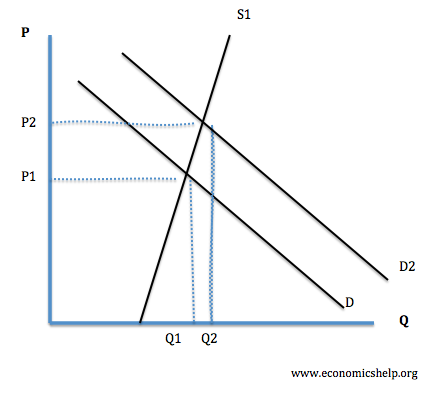Australia has a housing affordability problem, both for
renters and buyers. Labor has announced a policy to address this problem. It involves
subsidising landlords who rent properties for less than the market rate. If the
rent is 20% under market rate, the landlord gets $8500. This seems like a
sophisticated subsidy at first, but it isn’t at all.
The root causes of Australia’s housing affordability problem
are twofold. On the supply side, zoning restrictions and vested interests in
the boomer generation impede the construction of new (higher density) housing in
desirable locations, like along train lines. On the demand side, decades of
economically illiterate policies like the first-home-buyers grant have stoked
demand despite inelastic supply, resulting in price pass through and,
consequently, high prices. A quick illustration:

Figure 1.0 (above) depicts a market where demand is relatively more
elastic (flat) than supply. After the demand side is stoked by say, decreases
in interest rates, people’s willingness to pay increases and so does demand, to
D2. This higher price attracts more supply into the market. The
market equilibrium of housing sold increases to Q2, but this is a
relatively small change compared to the price shift. You get a small increase in quantity for a large increase in cost
because supply is inelastic. This is the story of housing in Australia:
restricted supply and policies that constantly fuel increases in demand.
Labor's policy makes no sense in this context as it doesn’t
address any of the root causes of unaffordable housing in Australia. What it
will do is shift some existing housing stock from slightly unaffordable to
slightly affordable at great cost to the taxpayer and great benefit to
land lords.
Let me put some numbers on this, borrowed from Cameron Murray, who does great work on real estate and corruption in Australia. The median rent in Australia is $462/wk, which is only $4800 p.a. At this median, $3700 of the subsidy will go to the landlord, the rest to the tenant. For lower priced homes, which are presumably the target of the policy, the situation is much worse. If the median rental in an area is $300/wk, the landlord only needs to offer a $60 discount ($3120 p.a.) to get $8500, enabling them to pocket $5380!
Let me put some numbers on this, borrowed from Cameron Murray, who does great work on real estate and corruption in Australia. The median rent in Australia is $462/wk, which is only $4800 p.a. At this median, $3700 of the subsidy will go to the landlord, the rest to the tenant. For lower priced homes, which are presumably the target of the policy, the situation is much worse. If the median rental in an area is $300/wk, the landlord only needs to offer a $60 discount ($3120 p.a.) to get $8500, enabling them to pocket $5380!
Moreover, note that the subsidy is a recurrent cost. Labor is suggesting that in the long run it will
inject $6billion dollars every year
into the real estate sector. This is 1970s shit. We know this kind of stuff is
economically toxic. This isn’t
even a band-aid solution: it’s pumping blood into someone continuously rather
than patching up their wound.
This policy is dumb in such elementary ways that I can only
assume some form of corruption or lobbying lies behind it. Best case scenario
this is some hack policy solution going into an election.
It might just be a hack idea drive by polling. Evidence for
this comes from the rollout rate, which seems to be extremely slow: only $102
million over the first four years post-election. Announce this for an election
and then quietly shelve it in the first budget, or certainly by the second
election.
Circumstantial evidence for lobbying is also present,
however. People on twitter immediately commented that this looks like a bailout
for off-the-plan builders. Rather than putting their newly constructed houses
and units up for sale on the shrinking Sydney real estate markets where they
won’t sell or collect low prices, this policy allow developers to put their properties
out to rent at good rates while they wait for the market to recover. It just so
happens that off-the-plan builders are a critical part of Labor’s base.
Like Cameron Murray, I don’t understand why the government doesn’t just build social
housing if that’s what it wants. There are so many ways to do this that don't involve a state owned enterprise (which I agree is dicey). You could inject capital into not-for-profits providing affordable housing so that they can build more units. You could create state builders with start-up capital, then immediately privatise them with a
not-for-profit mandate. They behave exactly like private companies (including
hiring subcontractors) except that they don’t price gouge in markets with
artificially restricted supply. You could give not-for-profit social housing charities first dibs on brownfield and greenfield development so that where social housing should be built, it does get built. Or you could copy the Vienna model (or Singapore). It makes
financial sense for the government too. The
AHURI estimates that it only costs $6500 per year to build and run a public
housing unit with a rental price of $155 per week. That’s a 75% discount on the
median rent! Go nuts. Housing is a merit good—something we think should be
distributed on the basis of need, not capacity to pay. I don’t see a reason why
the government shouldn’t be partially involved in the sector. A subsidy is just
a terrible way to do it.

Comments
Post a Comment